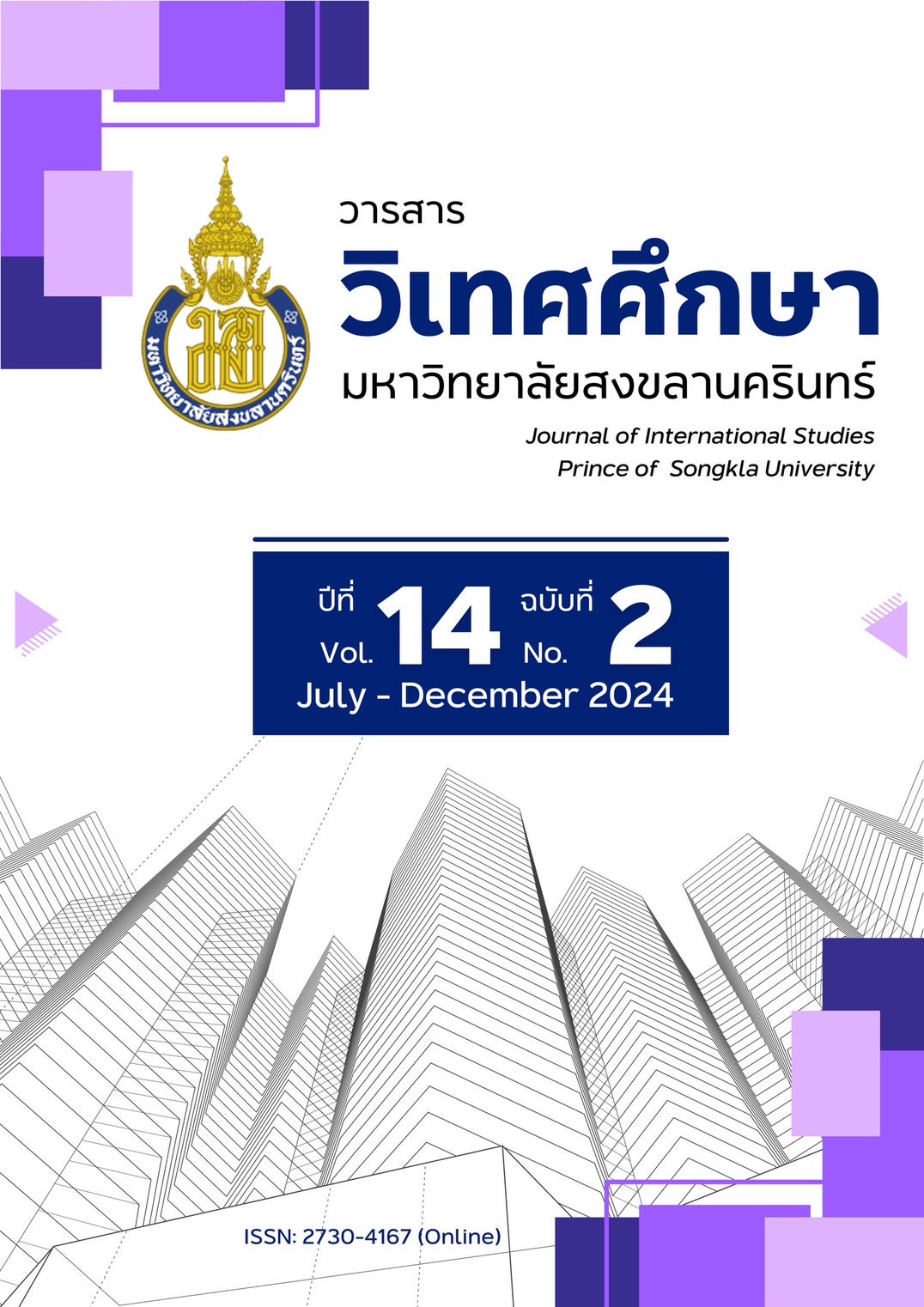A Comparative Study on Lilit Phra Lo and Butterfly Lovers: Symbols and Representation of Ideologies in Thai and Chinese Socio-cultural Perspectives
Main Article Content
Abstract
This study examined symbols and representations of ideologies and belief systems as well as similarities and differences of ideological perspectives, religious influences, and socio-cultural contexts in Lilit Phra Lo and Butterfly Lovers. This study applied a qualitative method by collecting secondary data and related research via documents and analytical descriptions of the socio-cultural context using a comparative approach and a content analysis approach to analyze the selected sample. Lilit Phra Lo represents syncretism of animist beliefs or supernatural power with Buddhism and Hinduism, which shape the identity of Thai culture. Butterfly Lovers, a Chinese folktale, reflects the elements of Confucianism and Taoism, the core of traditional Chinese society. Both tales play a significant role in reflecting ideologies and belief systems and constructing the cultural values in Thailand and China. The analysis indicates that both cultures cultivate respecting elders and obeying parents; however, there are several differences in ideological and religious influence due to social and cultural contexts. Chinese philosophies emphasize the principle of living harmoniously in society, but Thai people believe in the cause and effect of action. Moreover, both tales conveyed inequality and implications of gender hierarchy under a patronage system and a patriarchal society.
Article Details

This work is licensed under a Creative Commons Attribution-NonCommercial-NoDerivatives 4.0 International License.
Statements and opinions expressed in articles herein are those of the authors and do not necessarily reflect the position of the editors or publisher.
Article, information, text, image, etc. which are published in Journal of International Studies, belong to Journal of International Studies. If anybody or any organization would like to use part or whole of them, they must receive written permission from Journal of International Studies before usage.
References
Bascom, W. (1965). Four Functions of Folklore. In A. Dundes (Ed.), The Study of Folklore (pp. 279–298). Prentice-Hall.
Bickner, R. J. (2020). The Story of King Lo. Silkworm Books. (ISBN 978-6-16-215160-6)
Carter, A. (2021). Thailand’s fusion of religious beliefs: Buddhism, Animism and Brahmanism. Thaiger. https://thethaiger.com/news/national/thailands-fusion-of-religious-beliefs-buddhism-animism-and-brahmanism
China Net(中国网) (2005). Overview of Chinese History(中国历史概况). The Central People's Government of the People's Republic of China (中国人民共和国中央人民政府). https://www.gov.cn/test/2005-05/24/content_436.htm.
Dundes, A. (2007). MEANING OF FOLKLORE: The Analytical Essays of Alan Dundes (S. J. Bronner, Ed.). Utah State University Press.
Foy, G. (2019). Chinese Religions and Philosophies. Asia Society. https://asiasociety.org/chinese-religions-and philosophies.
Greetz, C. (1973). The Interpretation of Cultures (pp. 87–125, 193–233). Basic Books.
Guan, J. (关键英) (2019). 中国传统文化的独特气质 (The unique temperament of traditional Chinese culture). QSTHEORY. http://www.qstheory.cn/dukan/hqwg/2019-11/11/c_1125217538.htm
Hall, S. (1997). The Work of Representation. In Representation: Cultural Representations and Signifying Practices (pp. 13–74). SAGE Publications Ltd.
Hall, S. (2013). The Work of Representation. Retrieved from https://www.sagepub.com/sites/default/files/upm-binaries/ 55352 _Hall_ch_1.pdf
Hays, J. (2014). THAI SOCIETY: HIERARCHY, STATUS, CLASS, HI-SO CULTURE AND THE PATRON-CLIENT SYSTEM | Facts and Details. Factsanddetails.com. https://factsanddetails.com/southeast-asia/Thailand/sub5_8c/entry-3228.html.
Idema, W. L. (2010). The Legend of Liang Shanbo and Zhu Yingtai: Four Versions with Related Texts. Hackett Publishing.
Lévi-Strauss, C. (1955). The Structural Study of Myth. The Journal of American Folklore, 68(270), 428–444.
Malinowski, B., & Redfield, R. (1954). Magic, science and religion: and other essays. Doubleday.
Mark, J. J. (2020). Ancient Chinese Philosophy. World History Encyclopedia. https://www.worldhistory.org /Chinese_Philosophy/
McGee, R. J., & Warms, R. (2013). Symbolic and Interpretive Anthropology. SAGE Publications, Inc.
Rosser, S. V. (1992). Biology & Feminism: A Dynamic Interaction. Macmillan Reference USA.
Ruengruglikit, C. (2002). Reading Lilit Phra Law: Analysis and interpretation (อ่านลิลิตพระลอ ฉบับวิเคราห์และถอดความ). Chulalongkorn University Press.
Ruengruglikit, C. (2009). The Significance of Salahoen and Kaikaeo in Lilit Phra Lo. MANUSYA, 12(1), 1–10. https://doi.org/10.1163/26659077-01201001
Sathirakoset (Phraya Anumanratchathon) (1954). The tradition of Thai marriage (ประเพณีเรื่องแต่งงานบ่าวสาวของไทย) Rungrueang Tham.
Scroope, C. (2016). Thai Culture - Religion. Cultural Atlas. https://culturalatlas.sbs.com.au/thai-culture/thai-culture-religion.
Shirayama, Y., Phompida, S., & Kuroiwa, C. (2006). Modern medicine and indigenous health beliefs: malaria control alongside “Sadsana-phee” (animist belief system) in Lao PDR. Southeast Asian Journal of Tropical Medicine and Public Health, 37(4), 622–629.
Stefon, M. (2019). Chinese philosophy. Encyclopedia Britannica. https://www.britannica.com/topic/Chinese-philosophy.
Tarling, N. (1992). The Cambridge History of Southeast Asia: Volume 1, From Early Times to C.1800. Cambridge University Press.
Tourism Authority of Thailand. (2020). History & Geography & Geology. Tourism Authority of Thailand. https://www.tourismthailand.org/Articles/plan-your-trip-history-and-geography-geology.
Turner, V. (1967). The Forest of Symbols: Aspects of Ndembu Ritual (pp. 93–111). Cornell University Press.
Wanthana, S. (2019). Political Lessons from Lilit Phra Lor. Journal of Thai Studies, 1(6), 1–49.
Yarapirom, P. S., & Damrongpong, N. (2023). The Representation of Gender Definition through Ancient Chinese Folktales: Symbols of
Femininity Ideology, Negotiation, and Similarity of Female Status as Currently Era. Book of Proceedings of the 7th TICC International
Conference 2023 Titled Toward Sustainable Development Goals: Digital Transformation and Beyond, 444–461.
Yang, G. (杨国荣) (2015). 《庄子·齐物论》释义. 子夜星网站. http://www.ziyexing.com/files5/guwen/ guwen-30.htm.


